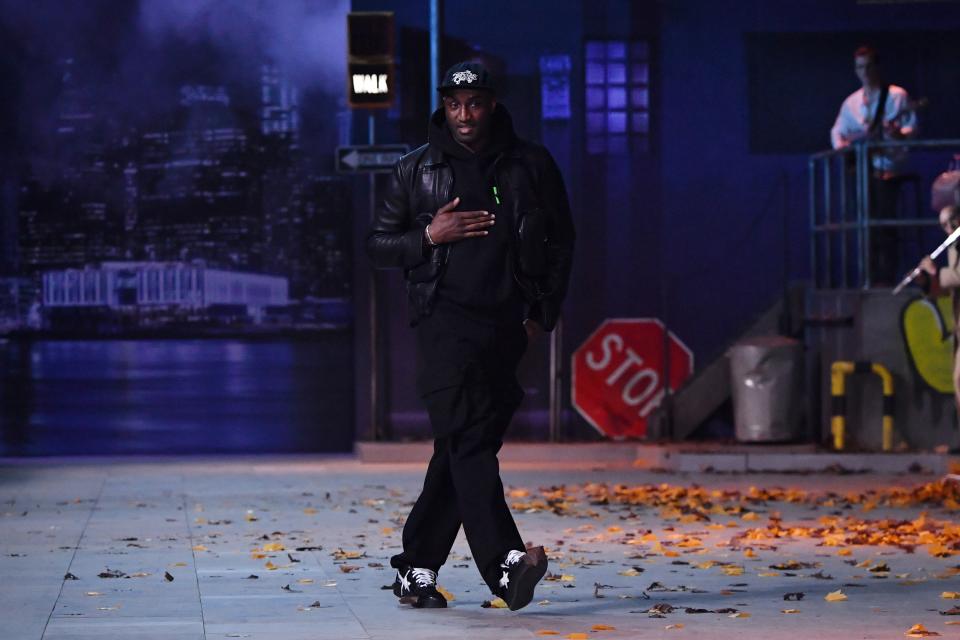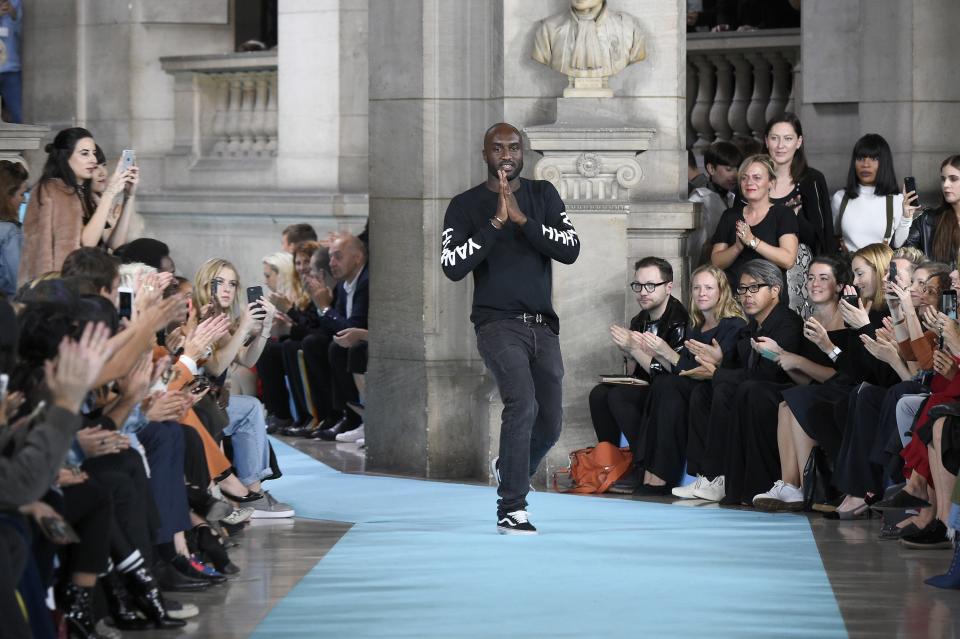What I Learned From Taking Virgil Abloh's Brand-Building Class
- Oops!Something went wrong.Please try again later.
Step 11 of “Free Game,” Virgil Abloh’s new platform meant to help aspiring designers create their own clothing lines, is simply titled “Personal Mentors.” The content of the “lesson” consists of an interview with Peter Savile, the graphic designer most famously known for Joy Division’s iconic Unknown Pleasures album artwork. “My personal mentor: Peter Saville - this video taught me millions of things,” the entirety of Abloh’s caption reads. In one choice anecdote from the interview, Saville describes going to a museum and being inspired to put Henri Fantin-Latour’s “A Basket of Roses” on the cover of New Order’s Power, Corruption & Lies. You may remember Abloh’s earliest Off-White pieces printed with Caravaggio’s work. “Free Game” positions Abloh similarly, an available mentor to would-be designers anywhere with an internet connection.
“Free Game” can tell us about more than just starting the next great American brand, though. You know what they say: if you really want to know someone, take their free online course on branding. And even a cursory run-through of the program reveals an awful lot about its creator: how he thinks about brands and design, his own roles at Off-White and Louis Vuitton, and the path to becoming a designer in 2020.
The stated goal of the Free Game is to help “brands in their earliest phases,” especially those within the black community. And what it reflects is the totally new and modern way that Abloh (and a few peers like him) came up within the fashion industry. There isn’t a step that suggests someone go to prestigious schools like Central Saint Martins in London or the Royal Academy of Fine Arts in Antwerp, which both produce designers with resumes ready made for the biggest ateliers. Instead, Abloh suggests that everything a person needs to know about getting started in the fashion industry is available within YouTube’s network: the stuff inside each step—the meat of the content—is an already-existing YouTube video, or several clips, on the topic. And why wouldn’t Abloh think that way, considering that he himself is not formally trained? Abloh climbed the ladder in the most unconventional way possible and now helms one of the most coveted positions in high fashion. The Free Game isn’t just a course for aspiring designers but the work of Abloh going back and retracing his own steps.

Louis Vuitton : Runway - Paris Fashion Week - Menswear F/W 2019-2020
The structure of the course mirrors the way Abloh says he approaches design. What Abloh’s done is assemble a course through already existing materials. Rather than creating something wholly original, Abloh’s grazed the internet for what he considers the very best information on the topic. The step on how to find wholesale blanks links out to a video from someone with the username Flex Mckenzie. One step simply contains old lectures Abloh has given. The course is not unlike Abloh’s previous work: a little bit of him mixed up with a lot of what's previously been done. It’s not so dissimilar from the way Abloh designs, constantly taking existing references and tweaking them ever so slightly. He calls it his 3% approach: taking an existing design or idea, like an Air Jordan, tweaking it three percent, and profiting.
Only the most literal-minded will find advice meant to be applied directly to your budding clothing line. The first step at the top of Free Game is “How to Name Your Brand.” This is the one Abloh approaches with the most piousness. “For me, the brand or entity name has been the most important part of my logic,” he writes. “Your brand name should be an endless reference point to why your brand exists.” Abloh famously landed on Off-White because he wanted to define “the grey area between black and white.” Looking at Abloh’s name—however nonsensical it might be: the area between black and white, as he himself points out, is grey, not off-white—might be more instructive than the video that follows. Abloh came up with a goal that inspired the name, which seems like pretty sound advice for kickstarting a brainstorm. Or at least that thinking may be more helpful than the advice that comes through in the embedded video: a TED Talk that includes the choice line “invented names can be highly unique but if you’re not careful, they can start to sound like pharmaceutical drugs or the name of a sofa from IKEA [mild laughter].”
Steps three through five, meanwhile, are peak Ablohian philosophy: how to use Adobe Creative Suite, how to screen print, and how to find the right blank T-shirts to put said screen prints on. Abloh makes it clear that this is a guide for brand’s in the earliest of stages but it’s telling that what goes unmentioned in Free Game is any sort of gesture towards a more classical way of making clothes. There are no videos here focused on sketching or the use of a sewing machine. The foundation of your brand is whatever you print on a T-shirt. Of course, this tracks with Abloh’s career. The designer got his start with Pyrex Vision, with Abloh grafting his own ideas onto blank Ralph Lauren rugby flannels.

Off-White : Runway - Paris Fashion Week Womenswear Spring/Summer 2017
The Free Game makes starting a brand seem all so easy: in 12 simple steps—some as straightforward as making a website and tacking on a Shopify—you can start a brand. Much of what we might consider the essential pillars of building a brand, like defining values or coming up with signature designs and hallmarks, are deemed not important enough, or potentially too advanced, to address in this course. This may very well be the future of fashion: aspiring designers sourcing blanks recommended by Abloh (by proxy), and then rising to the very top of the fashion food chain. (Come to think of it, this is what fashion’s present looks like, too.) But some advice is a little more advanced. Tellingly, the second step on Abloh’s guide—before even setting up a Shopify to sell a single screen-printed tee—is to obtain a trademark “to protect your intellectual property” In the Abloh universe, the idea is king—something sacred and deserving of the strongest guardianship. (Funnily enough, Abloh’s Off-White was taken to court by creative agency OffWhite Productions LLC, which lost the case because it did not sufficiently make the argument for its own trademark.)
At the very end of the course, Abloh lists a series of clips under “further inspiration.” The section starts conventionally enough for a fashion-minded course, with videos from iconic designers like Yohji Yamamoto and Marc Jacobs, before veering completely into Abloh territory with freestyle raps from the likes of Dipset, Abloh’s former boss Kanye, Lil Wayne, and Skepta. The references make sense within the larger context of Abloh’s career: the designer moonlights as a DJ and got his start as Kanye’s creative director. But Abloh teetering into his own deeply personal pursuits—one mostly removed from fashion—is maybe the best advice in Abloh’s entire course. Aspiring designers reading this might receive creative nourishment from Youtube videos detailing the distinctive calls of North American owls or Taiwanese New Wave cinema from the ‘90s. The biggest lesson of Abloh’s course might also be its simplest: if you want to start a brand, follow your own interests.
Originally Appeared on GQ

